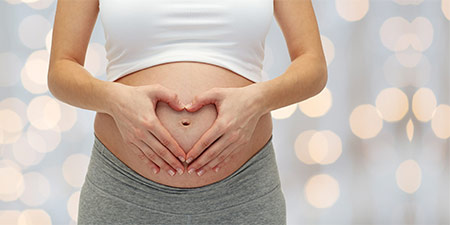The period of time between the beginning of a female menstrual period and the following menstrual period is generally referred to as the female cycle or the menstrual cycle. The length of the cycle plays a significant role, especially in the question of a woman’s fertility as well as in natural methods of pregnancy prevention. As a rule, a menstrual cycle lasts 28 days.
Here are briefly the most important facts you need to know:
- Information on the hormonal fluctuations.
- Phases in the cycle.
- Effect of duration.
- Fluctuations in the cycle
The hormonal fluctuations in the cycle
The phases of the female cycle
The first half of the cycle - the follicular phase
The female cycle begins with the first day of menstruation. During this period, the lining of the uterus, which has built up during the last phase of the cycle, is shed and flushed out. Many women feel the contractions as period pains and lose about 50 ml of blood in total. Menstruation lasts between 5 and 7 days. The hormone oestrogen then ensures that the mucous membrane in the uterus is rebuilt so that it can start working if an egg is fertilized. At the same time, follicles are formed in the ovary at the beginning of this phase, each of which contains an egg. The first phase of the menstrual cycle ends with ovulation, usually around the 14th day of the cycle.
The middle of the cycle - ovulation
The most developed follicle bursts at the ovulation stage, and thus releasing the egg, which then travels down the fallopian tube into the uterus. This process is also called ovulation. Here, the egg is capable of fertilization for a short time. The probability of pregnancy is highest shortly before and during ovulation.
The second half of the cycle - the luteal phase
The corpus luteum develops from the shell of the ruptured follicle, which, together with the hormone progesterone, stimulates the uterine lining to remodel. Vessels are strengthened, mucous vesicles are formed, and supporting tissue structures are built up. Meanwhile, if no egg is fertilized and does not implant, these structures would not be needed. The lining of the uterus is shed and expelled with the next bleeding. This marks the end of the cycle, and the cycle begins again.
How the duration of the cycle has an effect
The length of the cycle influences a woman's fertility. For example, if the first phase only lasts a few days, the egg has too little time to develop. Ovulation releases an immature egg that either cannot be fertilized at all. However, if it does work, then it has chromosomal defects. On the other hand, an excessively long first phase indicates that the body needs several attempts to mature an egg. However, delayed ovulation does not affect fertility. A shortening of the second half of the cycle indicates low progesterone levels, and this can make conception much more difficult. Nevertheless, if the period does not occur due to a very long second phase, a pregnancy test is recommended.
Cause of a fluctuating cycle
Women only notice a cycle that is similar to the day when the medication affects their hormones, for example, through the use of contraceptive pills. Many young women report an irregular cycle at the beginning. However, this is completely normal, as the entire system of hormones has to “settle in”. The cycle often only stabilises after the age of 20. With increasing age and especially before menopause (i.e., after the 45th birthday), the menstrual cycle becomes more irregular again until menstruation stops altogether.
Fluctuations in a woman's own menstrual cycle can also be due to her lifestyle. Irregularities after stopping the pill are typical. In this case, the body needs some time to regulate itself again. Great stress can upset the hormonal balance just as much as a diet over a longer period of time or stressful climatic changes. Competitive athletes also often suffer from fluctuations in their menstrual cycle. However, there are also some diseases that have an effect on a woman's cycle.
The need for medical advice
If the female cycle deviates greatly from the menstrual cycle (i.e., if it does not last longer than 20 days or lasts longer than 40 days), a woman should have the causes clarified by a doctor. In the long run, disturbances of the menstrual cycle can impair fertility, and a later wish for a child may remain unfulfilled. In case you become pregnant, please feel free to use our Due Date Calendar.
Watching the cycle
For women with irregular menstrual cycles, it is worthwhile to observe them more closely. That is, listening to your body's signals and noting symptoms. This is important for anyone who wants to have children. Today, specially developed ovulation tests or fertility apps can help.
What other readers have also read
More online calculators
Pregnancy Week Calculator, Ovulation Calculator, Overweight Children
Source information
As source for the information in the 'Due Date' category, we have used in particular:
Last update
This page of the 'Due Date' category was last edited or reviewed by Stefan Banse on November 29, 2024. It corresponds to the current status.
Changes in this category "Due Date"
- Publication of the guidebook on pregnancy test and the cycle lenth.
- Publication of the due date calculator
- Editorial revision of this page

